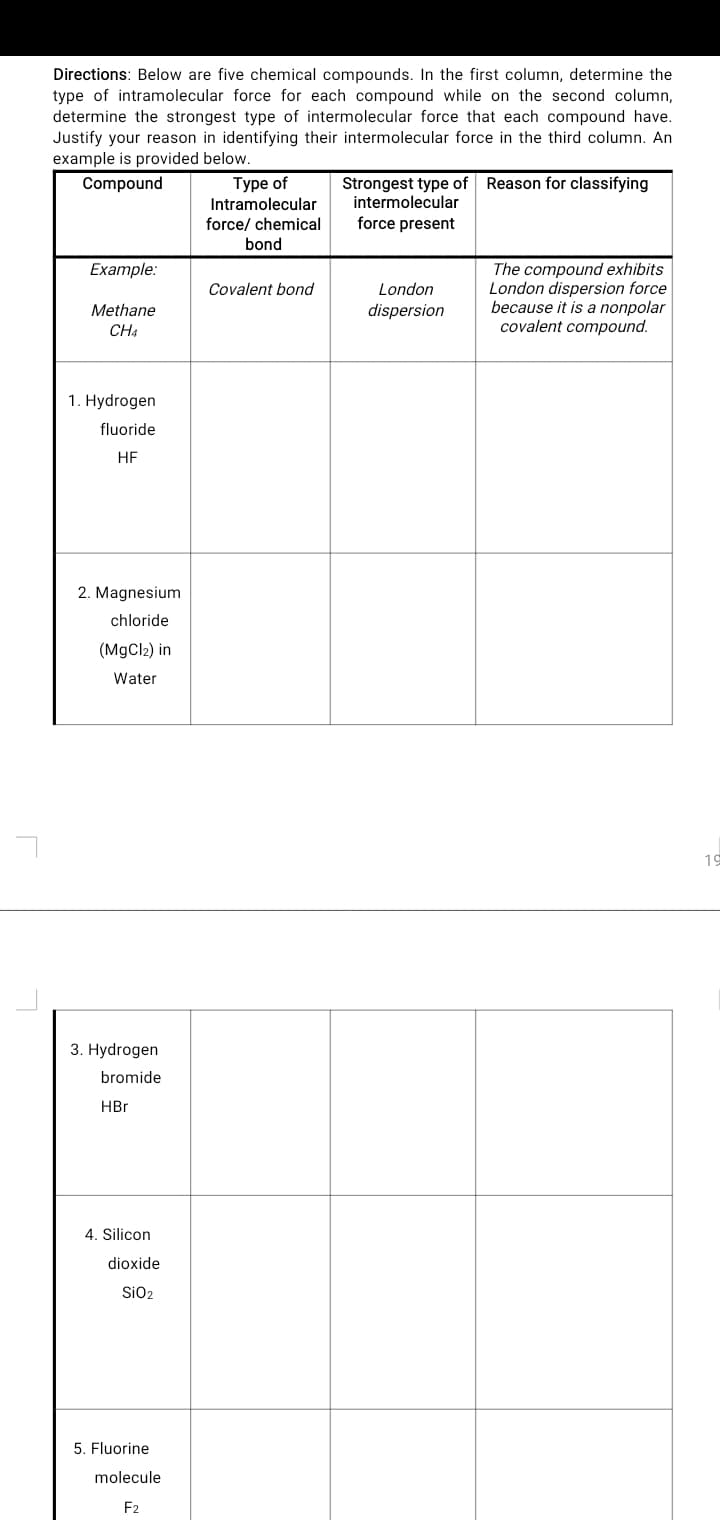Directions: Below are five chemical compounds. In the first column, determine the type of intramolecular force for each compound while on the second column, determine the strongest type of intermolecular force that each compound have. Justify your reason in identifying their intermolecular force in the third column. An example is provided below.
Directions: Below are five chemical compounds. In the first column, determine the type of intramolecular force for each compound while on the second column, determine the strongest type of intermolecular force that each compound have. Justify your reason in identifying their intermolecular force in the third column. An example is provided below.
Introductory Chemistry: An Active Learning Approach
6th Edition
ISBN:9781305079250
Author:Mark S. Cracolice, Ed Peters
Publisher:Mark S. Cracolice, Ed Peters
Chapter15: Gases,liquids, And Solids
Section: Chapter Questions
Problem 25E
Related questions
Question
100%

Transcribed Image Text:Directions: Below are five chemical compounds. In the first column, determine the
type of intramolecular force for each compound while on the second column,
determine the strongest type of intermolecular force that each compound have.
Justify your reason in identifying their intermolecular force in the third column. An
example is provided below.
Туре of
Strongest type of Reason for classifying
intermolecular
Compound
Intramolecular
force/ chemical
force present
bond
Example:
The compound exhibits
London dispersion force
because it is a nonpolar
covalent compound.
Covalent bond
London
Methane
dispersion
CH4
1. Hydrogen
fluoride
HF
2. Magnesium
chloride
(MgCl2) in
Water
19
3. Hydrogen
bromide
HBr
4. Silicon
dioxide
Si02
5. Fluorine
molecule
F2
Expert Solution
This question has been solved!
Explore an expertly crafted, step-by-step solution for a thorough understanding of key concepts.
This is a popular solution!
Trending now
This is a popular solution!
Step by step
Solved in 2 steps

Knowledge Booster
Learn more about
Need a deep-dive on the concept behind this application? Look no further. Learn more about this topic, chemistry and related others by exploring similar questions and additional content below.Recommended textbooks for you

Introductory Chemistry: An Active Learning Approa…
Chemistry
ISBN:
9781305079250
Author:
Mark S. Cracolice, Ed Peters
Publisher:
Cengage Learning


Chemistry: An Atoms First Approach
Chemistry
ISBN:
9781305079243
Author:
Steven S. Zumdahl, Susan A. Zumdahl
Publisher:
Cengage Learning

Introductory Chemistry: An Active Learning Approa…
Chemistry
ISBN:
9781305079250
Author:
Mark S. Cracolice, Ed Peters
Publisher:
Cengage Learning


Chemistry: An Atoms First Approach
Chemistry
ISBN:
9781305079243
Author:
Steven S. Zumdahl, Susan A. Zumdahl
Publisher:
Cengage Learning

Chemistry
Chemistry
ISBN:
9781305957404
Author:
Steven S. Zumdahl, Susan A. Zumdahl, Donald J. DeCoste
Publisher:
Cengage Learning

Introductory Chemistry: A Foundation
Chemistry
ISBN:
9781337399425
Author:
Steven S. Zumdahl, Donald J. DeCoste
Publisher:
Cengage Learning

Chemistry & Chemical Reactivity
Chemistry
ISBN:
9781133949640
Author:
John C. Kotz, Paul M. Treichel, John Townsend, David Treichel
Publisher:
Cengage Learning